According to Bahktin a Code is a deliberately killed Context. In this Blog I try to Code the Context without Killing it.
The word Context is derived from the Latin word con-textere which means Weaving (Textere) together (Con). The word textere is connected to words like Text, Archi-tect (Carpenter), Tech-nology (Craftmanship), Tekhne (Art), Textile, Texture and Textura (Web, Structure).
A Context is Something that Surrounds Something Else, Puts Something on its Place or Relates Something to Something Else that has a stronger Foundation. Other words that are part of the same Family are Frame of Reference, Setting, Environment, Background, Situation, Ambience, Circumstances, Fabric and Framework.
We can Taste, Smell, Feel (the Texture of the Skin), Create (Weaving), Look (Structure) and Emerge in a Context (Become One). Tasting, Hearing, Feeling and Smelling are Context-Independent. When we Taste, Hear, Touch or Smell we are In The Context.
Our Eyes are the Senses that are Context-Dependent. A Context changes when we Move Away from the Context. A Context is highly dependent on our Frame of Reference, our Point of View. If we change our Focus the context becomes vague or changes into another context. If we look at the Right Distance with the Right Angle the context is clear. We have reached the state of Clarity.
When we Move UP a context becomes a Surface. Moving Up changes the Landscape. Many Contexts merge into a One. When we have lost track we have to climb to a point where we can have an Overview. If we leave the Landscape and use an airplane the Landscape changes into a Map.
When we need to have an Overview we have to find the Right Scale. The word Scale means climbing and when we climb we stay in the Landscape that contains the Context we want to Observe.
When we look at a Context we can look at the Whole or we can look at the Parts. When we have no knowledge of the Context we are not able to define the Parts. There are infinite ways of defining the parts and all the time we define parts the Context disappears. The Parts become a context of their own.
If we understand the context we are able to determine the Whole and the Parts. When the context is created by a Human (an Archi-tect, Carpenter) we recognize the Whole by one or more distinctive Parts. A Door or a Window stands for a House. When the context is part of Nature we have no knowledge of the causal chain of creation. Nature is a Wonder, a Web that was never Woven.
If the context was constructed and we know about the Context we are able to arrange the parts and reconstruct the Context. If we have no idea about the genesis of the Context we are unable to reconstruct the Whole. If the context is destroyed we will never be able to repair it. Never deconstruct a context you don’t understand. You will never be able to recreate it.
If the context was created by a Craftsman (Tech-nology) You will always see the Sign of the Craftsman. A Craftsman is the creator of Art (Teckne) and strangely enough a piece of Art is never Perfect. When the Context is made by a Machine it is Perfect.
If we look at a Context we can point to it to show it to Others. We have to realize that the Others have a different Point of View. They see something else.
When we point to the Context and we want to make our point we can utter a sound. The sound can be related to the Whole (“house”) or to a Part (“window”). If the Other understands the Context he will recognize the Pointed Sounds and reply with his own Sounds (“huis”, “raam”). In this way we can reach mutual understanding about the Context. If You know about the Context and the other does not know about the Context he will only recognize the Whole but not the Parts.
We will never be able to utter enough words to describe the Context. A Context is a Picture and “a Picture Paints a Thousand Words”. When you want to explain a Context to Others make a Picture. Don’t use a Map because a Map is the result of a movement Up to get an Oversight. When you move to High you are Abstracting and Nobody will Understand you’re Abstraction. “A Map is not the Territory”
When you Ex-Plain something you are moving something out of “the plain” (a Flat Surface) to the Right Level. You have to move from the flat level of the Map or the Picture to the 3 dimensions of the Earth. Always take people with you to the Context and show them what is really happening out there. An explanation of a Map will never recreate the Experience of the Exploration of the real Territory.
A Context is always connected to the Emotions. You love the Animal. A house remembers you of your Childhood and you feel nostalgia. When you experience Beauty you have discovered the Whole. When the Emotions take you away you are not Focused. Look at the Context with the Eyes of an Innocent Child.
A Context always moves in Time. A house is designed, build, used and destroyed. The influence of Time can only be seen of you visit the Context often. If you are visiting the Context for the first time you can listen to others who tell the Stories that are connected to the Context. Sometimes a Context is a Focal point of many Stories. It has attracted many Visitors and has changed from an Object to a Texture. The Context is weaved by the experiences of many people (Con-textere).
The origin of the word Thinking is Thenkon which means “Making Visible” (I don’t See the Point, Insight). Thinking was also related to “Standing in the Middle” (Understand). To think you have to stop in the Center of the Context (The Right Point Of View). Later the meaning changed. Thinking became related to the Ears and Listening. The word Dumb means Deaf and you are Stupid when you don’t listen to the Person who Knows everything. When Thinking moved to the Head it became without Feeling. Think with you’re Body.
If you want to understand a Context walk around in the Landscape and Observe from the Right Point of View. Listen to the Stories of Others who have already found Clarity. Don’t believe you are Stupid when you’re Ears function. If you lost Oversight climb to the Right Scale but never leave Earth. If you do this the Worlds becomes flat and changes into a Map.
Act like a Crafsman. Use the Tech-nology of Your Body (Senses, Emotions, Imagination,Expectation) to Create Art (Tehkne). Never strive for perfection but improve Your Self. Weave (Textere) Beautifull Stories that bring Clarity to people that Think they are Dumb but cannot See.
Enjoy The Web (Textura) that was never Woven.
LINKS
 The Industrial Revolution started with the mechanization of the textile-industry (1740-1790) in England.
The Industrial Revolution started with the mechanization of the textile-industry (1740-1790) in England.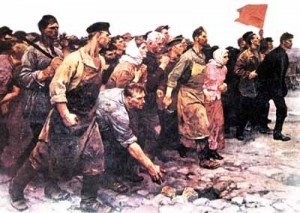 This tension was resolved when many pressure groups or movements (Conservatives, Liberals, Socialists, and Communists) finally agreed upon new large scale institutions.
This tension was resolved when many pressure groups or movements (Conservatives, Liberals, Socialists, and Communists) finally agreed upon new large scale institutions. 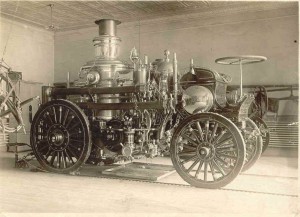 In 1781 Kant wrote his book Kritik der reinen vernunft. He excluded the Imagination (illusions) and the Emotions (love, care, values, quantity) out of reasoning and introduced the concept of mechanized thinking (Logic). Kant excluded Art (Imagination) and Religion (the Emotions) and invented Science.
In 1781 Kant wrote his book Kritik der reinen vernunft. He excluded the Imagination (illusions) and the Emotions (love, care, values, quantity) out of reasoning and introduced the concept of mechanized thinking (Logic). Kant excluded Art (Imagination) and Religion (the Emotions) and invented Science.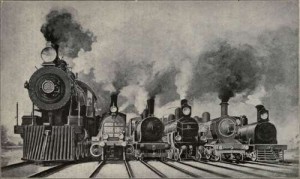 Between 1790 and 1840 the world was covered with Railroads. They facilitated the spread of the Industrial Revolution.
Between 1790 and 1840 the world was covered with Railroads. They facilitated the spread of the Industrial Revolution.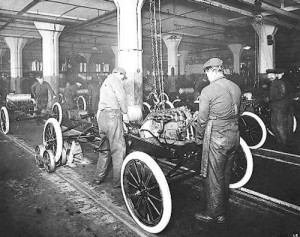 The first step was set by Henry Ford and Frederick Winslow Taylor with the production of the T-Ford. The theories of Taylor are until now (most of the time not recognized) used in many forms to optimize work-processes.
The first step was set by Henry Ford and Frederick Winslow Taylor with the production of the T-Ford. The theories of Taylor are until now (most of the time not recognized) used in many forms to optimize work-processes.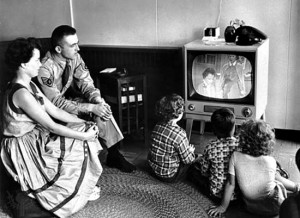 The Industrial Revolution gave the Masses, the Slaves of the Middle Ages a better place. They changed from a Slave into a Consumer.
The Industrial Revolution gave the Masses, the Slaves of the Middle Ages a better place. They changed from a Slave into a Consumer.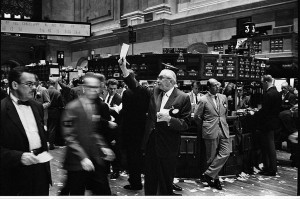 On the level of the
On the level of the 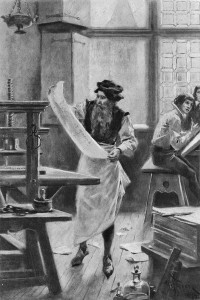 The printing press, invented in 1450, made it possible to distribute all the new knowledge all over the known world.
The printing press, invented in 1450, made it possible to distribute all the new knowledge all over the known world.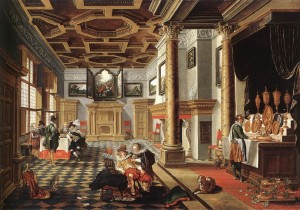 In the Arts the
In the Arts the 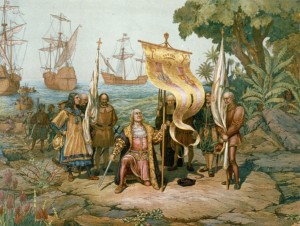 The need to convert others to the Christian faith was huge. Many expeditions, Crusades, were send out to unknown territory to find convertible humans.
The need to convert others to the Christian faith was huge. Many expeditions, Crusades, were send out to unknown territory to find convertible humans.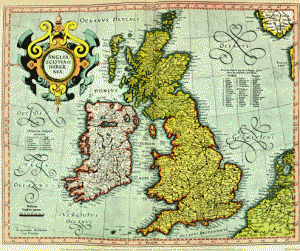 Production in the Renaissance was carried out by the Guilds, a Cooperation of Craftsman. They were almost in total control of every craft in the big cities.
Production in the Renaissance was carried out by the Guilds, a Cooperation of Craftsman. They were almost in total control of every craft in the big cities.
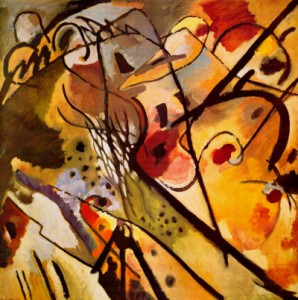
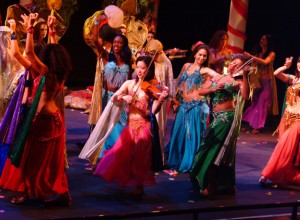
 The
The 